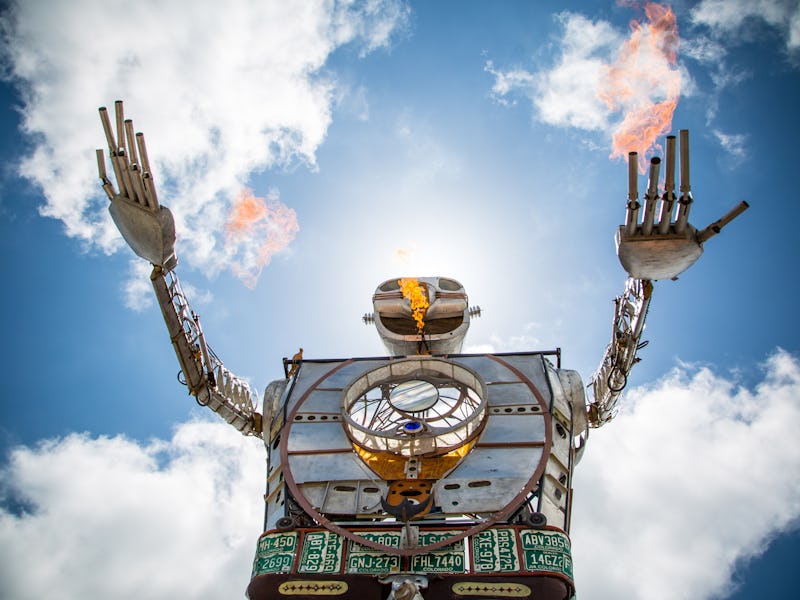World Maker Faire 2015: More Gadgets, More Creativity, More Flames
This celebration of all things STEM shows the beauty of building for building's sake.

For the sixth year in a row, World Maker Faire showed off some of the amazing things ordinary people can do with just a few tools, some second-hand building materials, and a whole lot of creative thinking. The New York Hall of Science (NYSCI) in Queens, New York was filled with people of all ages and backgrounds perusing the scenes of robots zipping around and creating art, do-it-yourself instruments that combined the hobbyist simplicity with 21st century pizzazz, emerging techie minds providing tips for newbie makers, and so much more. It’s where geeks go to geek out.
This was actually my first year to the New York Maker Faire — and any Maker Faire. I’d heard how incredible these events can be, but those thoughts only really strike you when you finally get to see what all the fuss is about. The maker movement is here, and I for one welcome our new DIY overlords.
The most immediate thing I noticed when I first walked into the NYSCI property was how much goes into creating an event that will appeal to people of all ages. On board The BioBus, for example, you immediately come face-to-face with three large displays showing off the miniature world of East River water as viewed from the microscopes beneath them. You can shift back and forth from a disgusting, awesome world of algae, protozoans, crustaceans like copepods, and so much more. Anyone who’s taken high school biology might not be so interested, but younger kids might get a kick out of seeing the galaxies alive in a smear of running water.
Nearby are the incredible robots built for and by kids. LEGO had their EV series robots there for children to play with. ArtBot Toys was showcasing their tripod automated bots that drew circular patterns on large tabletop papers. A kiddie pool had a remote-controlled, propeller-driven boat children could navigate with just a joystick.
Further away, the Life-Sized Mousetrap show — run by a ragtag group of show-people dressed in kitschy threads — demonstrated a giant’s Rube Goldberg device that ended up dumping a 600-pound safe onto an old, beat-up Chevy. (Although the show ran into a mishap when the weight unexpectedly dropped prematurely…) Special-guest Ahmed Mohamed was present to hit the switch and start the contraption.
And on the other side of that was the power-tool racing event, where kids lined up to race buzzsaws against one-another down a choppy wooden track.
There are plenty of more complex projects that sat around for visitors to gawk at. Wayne Strattman and his PlasmaBot sat in the Maker Faire darkroom doing little more than just looking really cool. The 7-foot electric marionette didn’t move too much, but it really didn’t need to — anyone in that room was prepared to stare at the damn thing for hours on end.
The UAV scene attracted quite the crowd when it pitted drone vs drone — two quadcopters facing off in a death-match rivaled only by the Thunderdome.
Okay, that’s a little over the top. Actually, the drone battles, for me, were quite the bust. At this point, I can’t really see what’s so great about watching two plastic vehicles trying to knock each other to the ground, especially when a gust of wind was capable of sending either into the netting that constituted the arena walls and ceiling.
And there were plenty more projects that didn’t seem to have much of a purpose besides to show off something “cool.” Guerrilla Science found a way to please music-lovers and pyromaniacs with an organ that breathed fire with every note played on a nearby piano. Just a few feet from that stood a 30-foot robot made of scrap metal moving around and shooting fire out its hands and mouth. Because why not?
But isn’t that the point of something like Maker Faire? That question, “why not?” is something that applies to the vast majority of these DIY projects and devices. They’re not really doing much besides demonstrating the ability to generate a bunch of wacky sights and sounds for passersby.
And the makers embrace that. These are people using scientific and engineering expertise to create things that don’t have much of a purpose, but they demonstrate just how fun STEM can be. It’s a far cry from the professional science and tech industries that try to weed out innovations that don’t display practical value (read: marketability). These makers, instead, are just trying to showcase something they loved working on — and they want to show people how it works and how they can make these things themselves.
Maker Faire is proof that sometimes, science and tech doesn’t need practical value to be meaningful — it can exist for the sheer joy of celebrating cool shit and the knowledge behind it.
Case in point: Two students, probably no older than 11 or 12, were sitting by the NYSCI building, waving around a can with a circle cut out from the bottom, and a plastic backing attached to the bigger opening in the back. They just filled up the can with fog, held it up, hit the plastic backing, and shot foggy smoke rings into my face. Just for the hell of it. They explained the simple physics behind it, but the drive to make something weird and tangible.
That’s Maker Faire in a nutshell: building stuff to watch people squirm and laugh and say “wow!” And then figuring out, what could it do next?